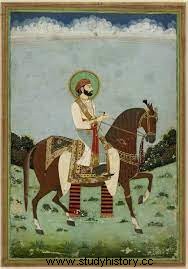
Birth and Early Life
Sawai Raja Jai Singh (II) was born on 3 November 1688 in the palaces of Amer from the womb of Raja Bishan Singh's Rathore queen Indra Kunwari. Indra Kunwari was the daughter of Kashi Singh Jodha, the Rathod feudatories of Khairwa. At that time the age of Raja Bishan Singh was only 16 years, so it is natural that the age of the mother of Raja Jai Singh must have been even less. The original name of this boy was Vijay Singh and his younger brother's name was Jai Singh. It is said that when Vijay Singh was eight years old, he was introduced to Aurangzeb. Aurangzeb was so impressed with Vijay Singh that he named the boy Jai Singh after his great-grandfather. At the same time, he was also given the title of Sawai because Aurangzeb felt that the amount of valor and eloquence in this child was one and a quarter times that of Mirza Raja Jai Singh. After this incident, elder brother came to be known as Jai Singh and younger brother as Vijay Singh.
Aurangzeb instructed to send the boy Jaisingh to the royal service immediately. Maharaja Bishan Singh got distracted by this order of Aurangzeb. Neither he could defy the royal order nor could he send the boy Jai Singh to the front. Therefore, he kept on making excuses for some time, but in the end in 1698 AD, Bishan Singh was compelled to send his ten-year-old son Sawai Jai Singh to the South Front in the service of Aurangzeb. After a few months, Maharaja Bishan Singh got the boy Jai Singh to be called again on the pretext of marrying him.
ascension
A few days after the arrival of Prince Jai Singh to Amber, his father Maharaja Bishan Singh died on the Afghan front. At that time the boy Jai Singh was only 12 years old. On 25 January 1700, Jai Singh was made the king of Amer State.
Political Situation of India
At the time when the twelve-year-old boy Jai Singh sat on the throne of the princely state of Amer, which was counted among the vast princely states of North India, at that time the political situation in India was very odd and full of nostalgia. The central authority of India was still in the clutches of the Mughals, but Aurangzeb's fanatical actions had alienated almost all the Hindu rulers of North and Central India from the Mughals. Ajit Singh, the ruler of Jodhpur, was wandering in the jungles after being deprived of his kingdom. Aurangzeb had made Rana Raj Singh of Mewar his worst enemy by getting a doll of the princess of Kishangarh. Maharaja Karan Singh of Bikaner was executed by Aurangzeb under humiliating circumstances. Aurangzeb's own son Akbar rebelled against his father and had become his enemy. To the south the Marathas were shaking the bricks of the Mughal Empire. Aurangzeb spent his energy in destroying remote kingdoms like Golconda and Bijapur only because the rulers there were Shia Muslims. From 1682 AD, Aurangzeb himself was holding a front in South India. Because of this Jats started raising their heads again in North India.
Amer's turbulent situation
However, before Jai Singh ascended the throne, eight generations of the Kachhwaha dynasty – Bharmal, Bhagwant Das, Mansingh, Bhav Singh, Jai Singh, Ram Singh, Kishan Singh (it was not sitting on the throne.) and Bishan Singh had served the Mughals relentlessly and they remained in the Mughal Sultanate. But Aurangzeb stopped trusting the Kachhwahas after Chhatrapati Shivaji fled from Agra. Therefore, now the state of Amer was not in the same condition as it was from the time of Raja Bharmal to Raja Mansingh. Aurangzeb kept Amber King Ram Singh entangled in terrible wars throughout his reign and also kept his mansab very low. The Kachhwaha kings had lost lakhs of their brave soldiers and lost crores of rupees to maintain the Mughal state, yet they were no more reliable for Jahangir, Shah Jahan and Aurangzeb.
Mirza Raja Jai Singh (1st) and Kunar Kishan Singh had died under mysterious circumstances. That is why the Mughals were looked upon with distrust in the state of Amer. The feudatories of Amer had become autocratic due to the continuous absence of seven generations of Kachhwaha kings from the Amer kingdom. Due to this, the military and governance system of the state was not running smoothly and no work was done for the welfare of the people.
